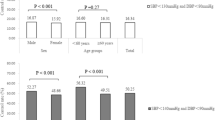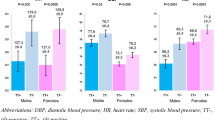Abstract
The object of this study was to examine blood pressure (BP) variability due to postural change in elderly hypertensive patients. The subjects studied were 154 elderly inpatients in a hospital for the elderly (48 male and 106 female; median age: 82 years), consisting of age- and sex-matched bedridden (n=39) and non-bedridden (n=39) normotensive controls and bedridden (n=38) and non-bedridden (n=38) hypertensive patients. BP and pulse rate (PR) were measured in the supine position, then again after a 2-min, 45 deg head-up tilt with the legs horizontal. The decrease in systolic BP (SBP) on tilting in the bedridden hypertensive group (median: −10 mmHg; range: −32 to 9 mmHg) was significantly (p<0.008) greater than those in the other three groups. Monotherapy with azelnidipine, a long-acting calcium channel blocker, for 3 months not only significantly reduced the basal BP and PR of hypertensive patients in the two groups, but also significantly (p<0.05) attenuated the tilt-induced decrease in the SBP to −3 mmHg (−19 to 25 mmHg) and enhanced the change in PR from −1 bpm (−10 to 7 bpm) to 1 bpm (−4 to 23 bpm) in the bedridden hypertensive group. Our findings indicate that tilt-induced decrease in SBP is a rather common phenomenon in bedridden elderly hypertensive patients, and that treatment with azelnidipine attenuates tilt-induced decrease in SBP, probably through an improvement of baroreceptor sensitivity.
Similar content being viewed by others
Article PDF
References
Masuo K, Mikami H, Habara N, Ogihara T : Orthostatic and postprandial blood pressure reduction in patients with essential hypertension. Clin Exp Pharmacol Physiol 1991; 18: 155–161.
Rose KM, Tyroler HA, Nardo CJ, et al: Orthostatic hypotension and the incidence of coronary heart disease: the Atherosclerosis Risk in Communities study. Am J Hypertens 2000; 13: 571–578.
Eguchi K, Kario K, Hoshide S, et al: Greater change of orthostatic blood pressure is related to silent cerebral infarct and cardiac overload in hypertensive subjects. Hypertens Res 2004; 27: 235–241.
Masaki KH, Schatz IJ, Burchfiel CM, et al: Orthostatic hypotension predicts mortality in elderly men: the Honolulu Heart Program. Circulation 1998; 98: 2290–2295.
Matsubayashi K, Okumiya K, Wada T, et al: Postural dysregulation in systolic blood pressure is associated with worsened scoring on neurobehavioral function tests and leukoaraiosis in the older elderly living in a community. Stroke 1997; 28: 2169–2173.
Kario K, Eguchi K, Hoshide S, et al: U-curve relationship between orthostatic blood pressure change and silent cerebrovascular disease in elderly hypertensives: orthostatic hypertension as a new cardiovascular risk factor. J Am Coll Cardiol 2002; 40: 133–141.
Tabara Y, Tachibana-Iimori R, Yamamoto M, et al: Hypotension associated with prone body position: a possible overlooked postural hypotension. Hypertens Res 2005; 28: 741–746.
Grap MJ, Munro CL : Quality improvement in backrest elevation: improving outcomes in critical care. AACN Clin Issues 2005; 16: 133–139.
Kuramoto K, Ichikawa S, Hirai A, Kanada S, Nakachi T, Ogihara T : Azelnidipine and amlodipine: a comparison of their pharmacokinetics and effects on ambulatory blood pressure. Hypertens Res 2003; 26: 201–208.
Arita M, Hashizume T, Tanigawa K, Yamamoto H, Nishio I : A new Ca-antagonist, azelnidipine, reduced blood pressure during exercise without augmentation of sympathetic nervous system in essential hypertension: a randomized, double-blind, placebo-controlled trial. J Cardiovasc Pharmacol 1999; 33: 186–192.
Kuroda K, Tatara K, Takatorige T, Zhao L, Shinsho F : Factors related to long-term stay in hospital by elderly people in a Japanese city. Age Aging 1992; 21: 321–327.
Katz S, Downs TD, Cash HR, Grotz RC : Progress in development of the index of ADL. Gerontologist 1970; 10: 20–30.
Bergstrom M, Braden BJ, Laguzza A, Holman B : The Braden scale for predicting pressure sore risk. Nurs Res 1987; 36: 205–210.
Niimi Y, Ieda T, Hirayama M, et al: Clinical and physiological characteristics of autonomic failure with Parkinson's disease. Clin Auton Res 1999; 9: 139–144.
Rosenthal MJ, Naliboff B : Postural hypotension: its meaning and management in the elderly. Geriatrics 1988; 43: 31–42.
Carvalho MJ, van den Meiracker AH, Boomsma F, et al: Improved orthostatic tolerance in familial amyloidotic polyneuropathy with unnatural noradrenaline precursor L-threo-3,4-dihydroxyphenylserine. J Auton Nerv Syst 1997; 62: 63–71.
Elmstahl S, Petersson M, Lilja B, Samuelsson SM, Rosen I, Bjuno L : Autonomic cardiovascular responses to tilting in patients with Alzheimer's disease and in healthy elderly women. Age Ageing 1992; 21: 301–307.
Gilbert VE : Immediate orthostatic hypotension: diagnostic value in acutely ill patients. South Med J 1993; 86: 1028–1032.
Gotshall RW, Wood VC, Miles DS : Modified head-up tilt test for orthostatic challenge of critically ill patients. Crit Care Med 1989; 17: 1156–1158.
Gehrking JA, Hines SM, Benrud-Larson LM, Opher-Gehrking TL, Low PA : What is the minimum duration of headup tilt necessary to detect orthostatic hypotension? Clin Auton Res 2005; 15: 71–75.
Tabara Y, Nakura J, Kondo I, Miki T, Kohara K : Orthostatic systolic hypotension and the reflection pressure wave. Hypertens Res 2005; 28: 537–543.
Riedl B, Beckmann T, Neundorfer B, Handwerker HO, Birklein F : Autonomic failure after stroke—is it indicative for pathophysiology of complex regional pain syndrome? Acta Neurol Scand 2001; 103: 27–34.
Hossain M, Ooi WL, Lipsitz LA : Intra-individual postural blood pressure variability and stroke in elderly nursing home residents. J Clin Epidemiol 2001; 54: 488–494.
Rutan GH, Hermanson B, Bild DE, Kittner SJ, LaBaw F, Tell GS, CHS Collaborative Research Group: Orthostatic hypotension in older adults. The Cardiovascular Health Study. Hypertension 1992; 19: 508–519.
Kassis E : Baroreflex control of the circulation in patients with congestive heart failure. Dan Med Bull 1989; 36: 195–211.
Ogi M, Kojima S, Kuramochi M : Effect of postural change on urine volume and urinary sodium excretion in diabetic nephropathy. Am J Kidney Dis 1998; 31: 41–48.
Morimoto S, Okaishi K, Onishi M, et al: Deletion allele of the angiotensin-converting enzyme gene as a risk factor for pneumonia in elderly patients. Am J Med 2002; 112: 89–94.
Tonkin AL, Wing LM : Effects of age and isolated systolic hypertension on cardiovascular reflexes. J Hypertens 1994; 12: 1083–1088.
Blomqvist CG, Stone HL : Cardiovascular adjustment to gravitation stress, in Shepherd JT, Abboud FM ( eds): Handbook of Physiology, Section 2, Vol III. American Physiological Society, Bethesda, pp 1025–1063.
James MA, Potter JF : Orthostatic blood pressure changes and arterial baroreflex sensitivity in elderly subjects. Age Ageing 1999; 28: 522–530.
Oizumi K, Miyamoto M, Koike H : Antihypertensive effect of CS-905, a novel dihydropyridine calcium blocker, in conscious hypertensive dogs. Jpn J Pharmacol 1990; 53: 264–266.
The Consensus Committee of the American Autonomic Society and the American Academy of Neurology : Consensus statement on thedefinition of orthostatic hypotension, pure autonomic failure, and multiple system atrophy. Neurology 1996; 46: 1470.
Masuo K, Mikami H, Ogihara T, Tuck ML : Changes in frequency of orthostatic hypotension in elderly hypertensive patients under medications. Am J Hypertens 1996; 9: 263–268.
Luukinen H, Koski K, Laippala P, Kivela SL : Prognosis of diastolic and systolic orthostatic hypotension in older persons. Arch Intern Med 1999; 159: 273–280.
Cleophas TJ, van Marum R : Age-related decline in autonomic control of blood pressure: implications for the pharmacological management of hypertension in the elderly. Drugs Aging 2003; 20: 313–319.
Koenig W, Binner L, Gabrielsen F, Sund M, Rosenthal J, Hombach V : Catecholamines and the renin-angiotensin-aldosterone system during treatment with felodipine ER or hydrochlorothiazide in essential hypertension. J Cardiovasc Pharmacol 1991; 18: 349–353.
Kassis E, Amtorp O, Waldorff S, Fritz-Hansen P : Efficacy of felodipine in chronic congestive heart failure: a placebo controlled haemodynamic study at rest and during exercise and orthostatic stress. Br Heart J 1987; 58: 505–511.
Kim-Mitsuyama S, Izumi Y, Izumiya Y, Yoshida K, Yoshiyama M, Iwao H : Additive beneficial effects of the combination of a calcium channel blocker and an angiotensin blocker on a hypertensive rat-heart failure model. Hypertens Res 2004; 27: 771–779.
Ertl AC, Diedrich A, Biaggioni I, et al: Human muscle sympathetic nerve activity and plasma noradrenaline kinetics in space. J Physiol 2002; 538: 321–329.
Mano T : Autonomic neural functions in space. Curr Pharm Biotechnol 2005; 6: 319–324.
Oizumi K, Nishino H, Miyake S, et al: Hemodynamic changes following long-term administration of CS-905, a novel dihydropyridine calcium blocker, in conscious SHR. Jpn J Pharmacol 1990; 54: 1–6.
Author information
Authors and Affiliations
Corresponding author
Rights and permissions
About this article
Cite this article
Morimoto, S., Takahashi, T., Okaishi, K. et al. Tilting-Induced Decrease in Systolic Blood Pressure in Bedridden Hypertensive Elderly Inpatients: Effects of Azelnidipine. Hypertens Res 29, 943–949 (2006). https://doi.org/10.1291/hypres.29.943
Received:
Accepted:
Issue date:
DOI: https://doi.org/10.1291/hypres.29.943



